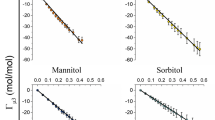Abstract
An IgM anti-group B Streptococcus monoclonal antibody (4B9) was found to undergo irreversible heat-induced aggregation at 50°C. A variety of excipients was tested for their ability to inhibit antibody aggregation. The amount of 4B9 aggregation, which was determined by analysis on a size-exclusion HPLC, was significantly reduced in the presence of low concentrations [between 0.1 and 1.0% (w/v)] of poly(vinylpyrrolidone) (PVP) molecules ranging in molecular weight from 10 to 40 kDa. When the PVP concentration was greater than 1.0%, antibody aggregation was enhanced, and with the highest molecular weight PVP, antibody precipitation occurred. HPLC was used to show that more PVP was associated with the 4B9 at 50°C than at 25°C. Differential scanning calorimetry revealed that PVP concentrations greater than 2.0% decreased the antibody thermal transition temperature. Enzyme-linked immunosorbent assays were used to assess the effects of PVP on the antigen binding capacity of 4B9 and on 4B9 quantitation. At 4°C, PVP solutions of up to 5.0% had no effect on either 4B9 quantitation or antigen binding. At 50°C, however, less 4B9 was detected in the 5.0% PVP solution. The heat stabilization of the 4B9 antibody by low concentrations of PVP can be explained by a weak binding of PVP to the native protein. The PVP may sterically interfere with protein–protein interactions, thus reducing aggregation. Higher concentrations of PVP lead to protein aggregation and precipitation, probably by a volume-exclusion mechanism. Low concentrations of less than 1.0% PVP can be used to stabilize proteins against heat-induced aggregation, but care should be exercised, since even slightly higher concentrations of PVP can also lead to protein destabilization.
Similar content being viewed by others
REFERENCES
M. C. Manning, K. Patel, and R. T. Borchardt. Stability of protein pharmaceuticals. Pharm. Res. 6:903–918 (1989).
Y. J. Wang and M. A. Hanson. Parenteral formulations of proteins and peptides: Stability and stabilizers. J. Parent. Sci. Tech. Suppl. 42:S3–S26 (1988).
H. D. Ochs. Safety and patient acceptability of intravenous immune globulin in 10% maltose. Lancet Nov. 29:1158–1159 (1980).
C. S. Henney and E. F. Ellis. Antibody production to aggregated human gamma G-globulin in acquired hypogammaglobulinemia. N. Engl. J. Med. 278:1144–1146 (1968). J. Hermans. J. Chem. Phys. 77:2193–2203 (1982).
T. Arakawa, Y. Kita, and J. F. Carpenter. Protein-solvent interactions in pharmaceutical formulations. Pharm. Res. 8:285–291 (1991).
C. H. Schein. Solubility as a function of protein structure and solvent components. Biotechnology 8:308–317 (1990).
T. Arakawa, R. Bhat, and S. N. Timasheff. Why preferential hydration does not always stabilize the native structure of globular proteins. Biochemistry 29:1924–1931 (1990).
J. C. Lee and S. N. Timasheff. The stabilization of proteins by sucrose. J. Biol. Chem. 256:7193–7201 (1981).
S. N. Timasheff and T. Arakawa. Stabilization of protein structure by solvents. In T. E. Creighton (ed.), Protein Structure. A Practical Approach. IRL Press, New York, 1989, pp. 331–345.
L. L. Lee and J. C. Lee. Thermal stability of proteins in the presence of poly(ethylene glycols). Biochemistry 26:7813–7818 (1987).
T. Arakawa and S. N. Timasheff. Stabilization of protein structure by sugars. Biochemistry 21:6536–6544 (1982).
K. Gekko and S. N. Timasheff. Thermodynamic and kinetic examination of protein stabilization by glycerol. Biochemistry 20:4677–4686 (1981).
T. Arakawa and S. N. Timasheff. Preferential interactions of proteins with salts in concentrated solutions. Biochemistry 21:6545–6552 (1982).
T. Arakawa and S. N. Timasheff. Mechanism of poly(ethylene glycol) interaction with proteins. Biochemistry 24:6756–6762 (1985).
R. Bhat and S. N. Timasheff. Steric exclusion is the principal source of the preferential hydration of proteins in the presence of polyethylene glycols. Protein Sci. 1:1133–1143 (1992).
K. C. Ingham. Precipitation of proteins with polyethylene glycol: Characterization of albumin. Arch. Biochem. Biophys. 186:106–113 (1978).
K. C. Ingham. Protein precipitation with polyethylene glycol. Meth. Enzymol. 104:351–356 (1984).
D. H. Atha and K. C. Inghams. Mechanism of precipitation of proteins by polyethylene glycols: Analysis in terms of excluded volume. J. Biol. Chem. 256:12108–12117 (1981).
J. L. Cleland and T. W. Randolph. Mechanism of polyethylene glycol interaction with the molten globule folding intermediate of bovine anhydrase B. J. Biol. Chem. 267:3147–3153 (1992).
H. V. Raff, P. J. Siscoe, E. A. Wolff, G. Maloney, and W. Shuford. Human Monoclonal antibodies to group B streptococcus. J. Exp. Med. 168:905–917 (1988).
L. Blecher, D. H. Lorenz, H. L. Lowd, A. S. Wood, and D. P. Wyman. Polyvinylpyrrolidone. In R. L. Davidson (ed.), The Handbook of Water-Soluble Gums and Resins, McGraw-Hill, New York, 1980, pp. 21-1–21-21.
R. A. Harrison. Preliminary characterization of the multiple forms of ram sperm hyaluronidase. Biochem J. 252:875–882 (1988).
M. S. Townsend and P. P. DeLuca. Use of lyoprotectants in the freeze-drying of a model protein, ribonuclease A. J. Parent. Sci. Technol. 42:190–199 (1988).
A. Polson, G. M. Potgieter, J. F. Largier, G. E. Mears, and F. J. Joubert. The fractionation of protein mixtures by linear polymers of high molecular weight. Biochim. Biophys. Acta 82:463–475 (1964).
C. Jackson, L. M. Nilsson, and P. J. Wyatt. Chearcterization of biopolymers using a multi-angle light scattering detector with size exclusion chromatography. J. Appl. Polym. Sci. 43:99–114 (1989).
E. Bos, A. van der Doelen, N. van Rooy, and A. Schuurs. 3,3′,5,5′-tetramethylbenzidine as an Ames test negative chromogen for horseradish peroxidase in enzyme immunoassay. J. Immunoassay 2:187–196 (1981).
V. V. Mozhaev and K. Martinek. Inactivation and reactivation of proteins (enzymes). Enzyme Microbiol. Technol. 4:299–309 (1982).
P. Molyneux. Synthetic polymers. In F. Franks (ed.), Water, a Comprehensive Treatise, Vol. 4. Aqueous Solutions of Amphiphiles and Macromolecules. Franks, Plenum Press, New York, 1975, pp. 569–757.
F. Franks. Water, a Comprehensive Treatise, Vol. 7. Water and Aqueous Solutions at Subzero Temperatures, Plenum Press, New York, 1982, p. 263.
G. F. Doebbler. Cryoprotective compounds, review and discussion of structure and function. Cryobiology 3:2–11 (1966).
Author information
Authors and Affiliations
Rights and permissions
About this article
Cite this article
Gombotz, W.R., Pankey, S.C., Phan, D. et al. The Stabilization of a Human IgM Monoclonal Antibody with Poly(vinylpyrrolidone). Pharm Res 11, 624–632 (1994). https://doi.org/10.1023/A:1018903624373
Issue Date:
DOI: https://doi.org/10.1023/A:1018903624373




